Product management is more important than ever in 2025. With over 3 to 4 million product managers working globally, the demand for smart tools to manage ideas, feedback, and roadmaps is at an all-time high. The product management software market is worth $30.31 billion in 2024 and is expected to reach $52.85 billion by 2032, growing steadily each year.
More than 1 in 5 product managers now use AI tools to improve decision-making, and 41% of companies rely on data and analytics to shape their product strategies. Even though product management is growing, job listings have recently dropped by 4.6% in May 2025, showing how competitive the space is.
To help you stay ahead, we’ve put together a list of the 10 best product management software tools you should know about this year.
Why Product Management Software is a Game-Changer in 2025
- Turns feedback into action: Modern tools help teams collect user feedback from multiple channels (emails, CRMs, support tickets) and turn that input into actionable product ideas, leading to better customer-focused features.
- Bridge the gap between strategy and execution: Product software connects high-level goals like OKRs and product vision with daily tasks and development sprints, ensuring that no feature is built in isolation.
- Improves cross-functional collaboration: These tools provide shared dashboards, comments, file sharing, and real-time updates so product managers, developers, designers, and stakeholders can work in sync without confusion.
- Increases transparency and accountability: Everyone involved knows what’s being worked on, by whom, and by when—reducing miscommunication, duplicated efforts, and project delays.
- Reduces product delivery time: By streamlining workflows and automating repetitive steps like status tracking, email notifications, and progress reports, these tools help teams ship features faster and more efficiently.
Key Things to Consider Before Choosing a Product Management Tool
- Team size & workflow needs: Startups may prefer simple and visual tools like Trello or Monday.com, while larger teams handling complex roadmaps might need tools like Aha! or Jira with advanced workflows.
- Integration with existing tools: The software should easily connect with tools your team already uses—like Slack for communication, Jira for development, or Google Drive for file sharing—so nothing falls through the cracks.
- Customization and flexibility: The tool should allow you to create your own views, fields, tags, and prioritization formulas so it can match your unique product methodology (Agile, Scrum, Kanban, etc.).
- Ease of use and learning curve: A powerful tool isn’t helpful if it’s too complex to use. Look for a clean interface, onboarding help, and a strong knowledge base or customer support.
- Cost and scalability: Some tools offer great free tiers for small teams, but pricing can climb quickly with added features or more users. Make sure it’s cost-effective both now and as your team grows.
Top 10 Best Product Management Software
1. Airfocus
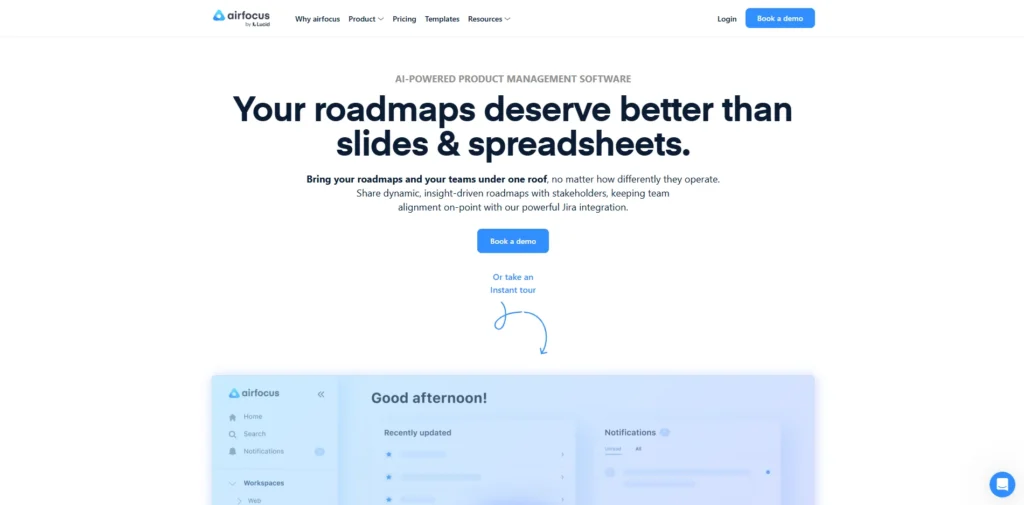
Airfocus allows teams to sort their product projects and build detailed road maps centered on business achievements. Using customizable things like value, effort, risk and cost, teams can use Agile to rank features and initiatives effectively. Thanks to its straightforward interface, Airfocus helps product managers plan their work without it becoming complicated.
What stands out about Airfocus is how flexible it is. Users are able to make product workspaces by selecting modules from strategy, feedback, prioritization and roadmapping. The platform supports strategies like OKRs and goal management which ensure that all product decisions relate to the main company goals. With features for Jira, Trello, Intercom and Microsoft Teams, Airfocus is flexible for today’s agile teams.
Top Features:
- Prioritization scoring with customizable formulas
- Modular product management workflows
- Feedback portal with AI-powered insights
- Product roadmaps and timeline views
- OKRs and business alignment tools
Website: https://airfocus.com/
Pricing:
| Core | Scale | Enterprise |
| $59/mo | Available on request | Available on request |
2. Roadmunk
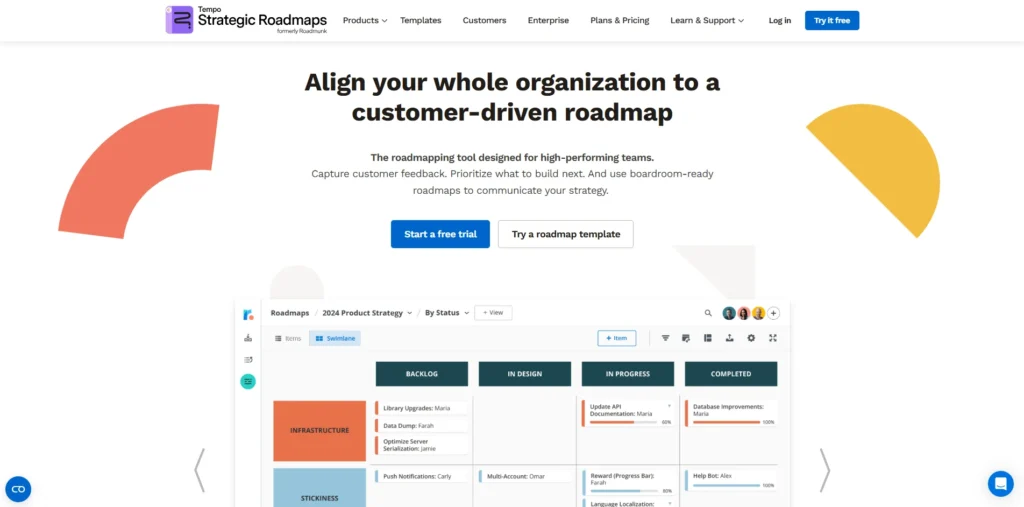
Roadmunk is a special roadmapping tool that lets you easily design and share simple, data-filled roadmaps. Roadmaps are especially loved by product teams that want to share their plans with the whole company. With Roadmunk, organizations can present their plans in either timeline or swimlane views.
Roadmunk is unique because it allows users to organize and improve ideas easily. Team members can get new product ideas from customers, inside the company or by using other systems and work together to decide which ideas have the most value and are easiest to implement. Because of customizable roadmap templates, advanced filters and different publishing methods, PMs are able to design roadmaps suitable for executives, developers or customers.
Top Features:
- Visual roadmap creation (timeline and swimlane views)
- Centralized idea and feedback management
- Drag-and-drop prioritization and planning
- Custom roadmap templates and views
- Integration with Jira, Azure, Slack, and more
Website: https://roadmunk.com/
Pricing:
| Starter | Business | Professional | Enterprise |
| $19/mo | $49/mo | $99/mo | Custom |
3. Monday.com

Many product teams rely on Monday.com as their work operating system for roadmap management, processing feedback and teamwork across different areas. It has flexible boards that allow you to manage the backlog, set up sprints and follow plan launches in your own way. The software’s simple design and automated tools allow everyone to stay on the same page.
Monday.com includes ready-to-use templates for managing product roadmaps, planning sprints, tracking features, and managing each stage of the product development process. Customer feedback can be easily added to teams’ regular operations by using forms or connecting to specific AI CRM tools, enabling smarter insights and more efficient customer relationship management. As a result, product managers have support for Gantt charts, timelines, and Kanban boards to help them manage their work.
Top Features:
- Visual project boards and customizable workflows
- Roadmap, backlog, and sprint planning templates
- Real-time team collaboration and file sharing
- Automation rules and custom alerts
- Integration with Slack, GitHub, and CRM tools
Website: https://www.monday.com/
Pricing:
| Free | Basic | Standard | Pro | Enterprise |
| $0 | $9/mo | $12/mo | $19/mo | Custom |
4. Asana

Many product teams choose Asana as their product management platform to plan and execute their product strategies. Because of its versatile design, Asana can be adjusted for backlog grooming, planning sprints, managing launches and roadmap management, outside its primary role. It is simple for product managers to assign persons, choose when work is due and see how the project is developing.
You can use Asana to create timelines, track your goals, handle milestones and automate workflows, all vital for managing the life cycle of a product. Product teams are able to combine Asana with tools for capturing feedback, finding bugs and talking to each other in Slack or Teams, so all the details are kept in one place.
Top Features:
- Product roadmap and task planning with timeline view
- Goals and milestone tracking
- Templates for feature launches and sprints
- Integration with over 100+ apps and tools
- Easy collaboration with comments, attachments, and updates
Website: https://asana.com/
Pricing:
| Personal | Starter | Advanced |
| $0 | $10.99/mo | $24.99/mo |
5. Trello (with Power-Ups)

Atlassian’s Trello is a versatile Kanban-style collaboration application that can be made into a lightweight, effective product management system by adding “Power-Ups.” Trello is usable by teams of all sizes because of its straightforward drag-and-drop board interface.
Small to medium-sized teams that require flexibility but value simplicity will find Trello to be incredibly effective. Project managers can make boards for managing customer input, monitoring bugs, feature prioritization, and product roadmaps. Every product workflow is made more structured with the use of unique labels, checklists, and templates.
Top Features:
- Drag-and-drop Kanban interface
- Power-Ups for roadmaps, calendar, voting, and more
- Custom fields, labels, and checklists
- Collaboration with comments, mentions, and file uploads
- Integration with programs such as Slack, Google Drive, and Jira
Website: https://trello.com/
Pricing:
| Free | Standard | Premium | Enterprise |
| $0 | $5/mo | $10/mo | $17.50/mo |
6. Jira Product Discovery

Atlassian has designed Jira Product Discovery for use by product managers in managing their product ideas. It uses the tools available in the Jira ecosystem to support all stages of planning your product. Product teams can gather insights, relate their ideas to business objectives and form understandable and workable roadmaps by using the tool.
Thanks to its emphasis on working together and openness, Jira Product Discovery supports stakeholders by making visual plans, arranging backlogs by priority and using facts from data. Product science enables teams to view new insights immediately and relate them to their goals.
Top Features:
- Idea backlog with priority scoring
- Roadmap views and progress tracking
- Integration with Jira Software
- Feedback collection and insights linking
- Collaboration and voting on product ideas
Website: https://www.atlassian.com/software/jira/product-discovery
Pricing:
| Free | Standard | Premium |
| $0/mo | $10/mo | $25/mo |
7. Productboard
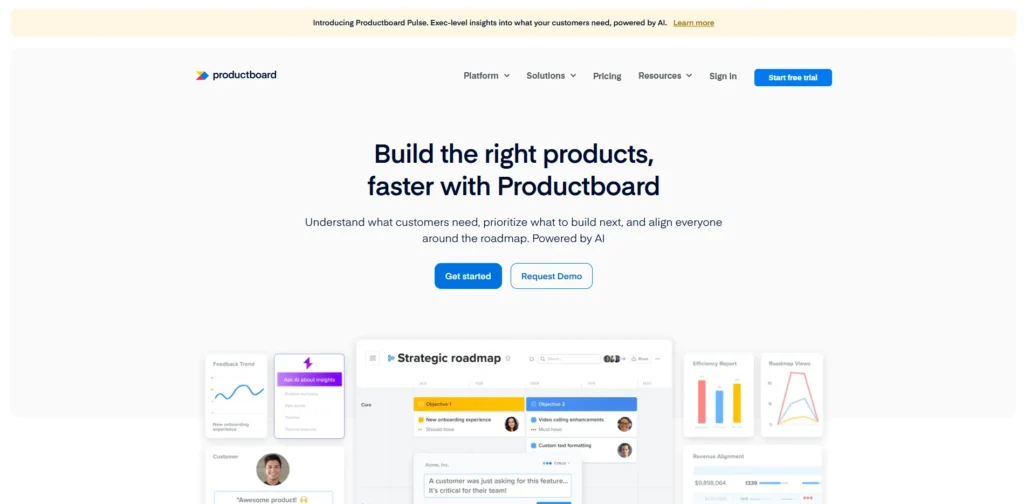
Productboard is software used by teams to gather customer needs, choose which features to develop and develop a shared strategy for the product. It’s where product suggestions, customer input and teamwork are closely tied. Productboard makes it possible for PMs to prioritize new features by relying on user data, the importance to the business and the product’s objectives.
Thanks to tools such as timelines and roadmaps, the platform helps everyone understand the company’s product plans more clearly. Besides, it connects to several tools like Slack, Intercom and Salesforce so it can automatically supply you with customer information. For companies that center product development around customers, Productboard is the perfect option.
Top Features:
- Customer feedback collection and tagging
- Feature prioritization frameworks (RICE, value vs effort)
- Customizable product roadmaps
- Integration with customer and development tools
- Portal for public product feedback
Website: https://www.productboard.com/
Pricing:
| Starter | Essential | Pro | Enterprise |
| $0 | $19/mo | $59/mo | Contact Sales |
8. Aha! Roadmaps
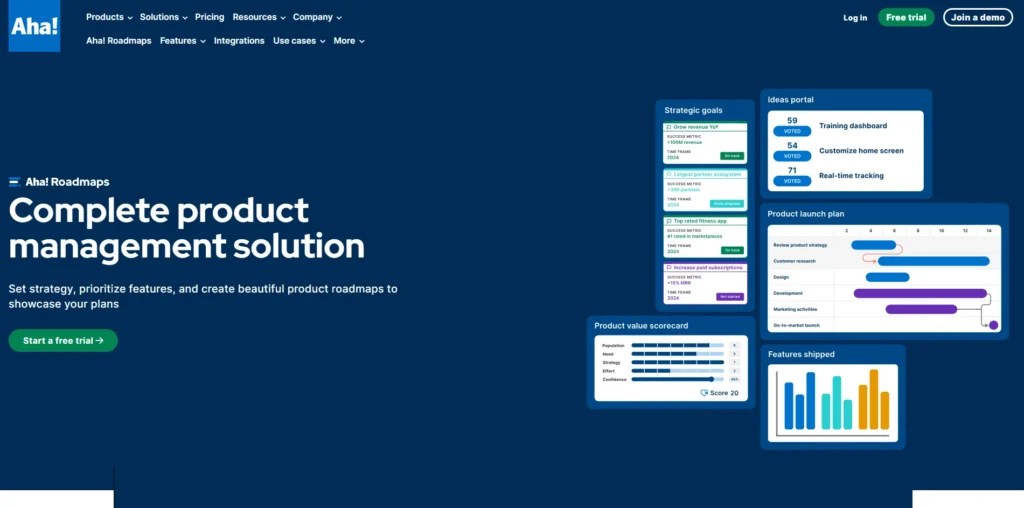
Aha! Roadmaps is a comprehensive product management suite used by thousands of companies to set product strategies, define features, and build collaborative roadmaps. It allows product managers to define goals, initiatives, and detailed feature lists while tying them directly to customer needs and business objectives. The visual interface supports Gantt charts, Kanban boards, and roadmap timelines for effective planning and communication.
Aha! stands out for its robust strategic planning capabilities. Teams can perform SWOT analysis, define personas, and conduct competitive analysis—all within the same platform. It also allows two-way integration with development tools like Jira, Azure DevOps, and GitHub, enabling seamless handoff from planning to execution. The tool is highly customizable, making it suitable for companies of all sizes and industries.
Top Features:
- Strategic product planning with goals and initiatives
- Detailed feature and release planning
- Visual roadmaps and Gantt charts
- Integration with engineering tools
- Customizable workflows and fields
Website: https://www.aha.io/roadmaps/overview
Suggested Read: Dropshipping Product Research Tools
9. ClickUp

ClickUp is a versatile project and product management platform that combines task management, documentation, goal tracking, and real-time collaboration. It’s highly popular among product teams because of its flexible structure, allowing you to customize how you manage features, sprints, feedback, and product goals. From Kanban boards and Gantt charts to doc creation and time tracking, ClickUp covers a broad spectrum of product management needs.
ClickUp’s hierarchy system (Spaces, Folders, Lists, and Tasks) allows for organized and scalable product structures. The platform supports templates for product roadmaps, backlog grooming, and release cycles. ClickUp also enables integration with a wide range of tools including GitHub, Slack, and Figma, and offers powerful automation options. It’s particularly favored by startups and small to mid-sized businesses for its affordability and wide feature set.
Top Features:
- Custom product roadmaps and backlog boards
- Built-in document creation and collaboration
- Task dependencies, time tracking, and goals
- Wide range of integrations and automation
- Custom fields, views, and reporting dashboards
Website: https://clickup.com/
Pricing:
| Free | Unlimited | Business | Enterprise |
| $0 | $7/mo | $12/mo | Contact Sales |
10. Craft.io
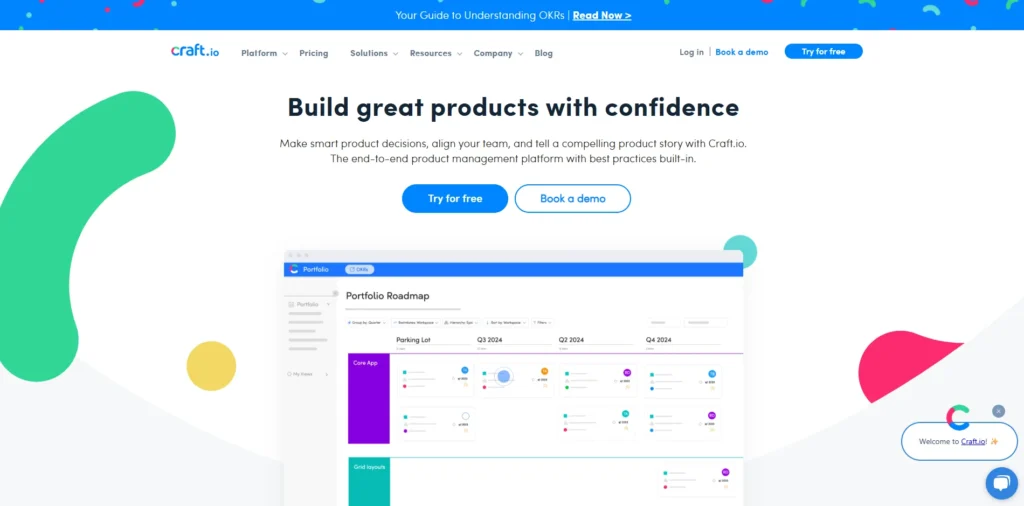
Product specialists created Craft.io, a platform for product teams to manage their products. It’s designed to provide a complete environment for managing the product lifecycle—from capturing ideas to setting priorities and building roadmaps. Craft.io’s Strength lies in its unique “Product Spec” framework, where you can add detailed specs, user stories, and prioritization scores to each feature or initiative.
One of the standout features of Craft.io is its ability to provide strategic context throughout the product life cycle. Teams can define their product vision, user personas, and value drivers, which can be linked directly to features and tasks. This ensures that everything being built is aligned with the overall product and business goals. It also supports multiple roadmap formats and offers real-time collaboration features, making it a strong tool for cross-functional teams.
Top Features:
- Product spec documents linked to roadmap items
- Built-in prioritization frameworks (RICE, MoSCoW, etc.)
- Persona and goal linking for strategic alignment
- Customizable roadmaps and views
- Seamless integrations with Jira, Slack, and Azure
Website: https://craft.io/
Pricing:
| Starter | Pro | Enterprise |
| $19/mo | $79/mo | Custom |
Conclusion
In conclusion, choosing the right product management software can make a huge difference in how smoothly your team works and how successful your product becomes. The appropriate tool helps you stay organized, prioritize better, and deliver faster, whether you’re a major organization managing several roadmaps or a startup developing your first product.
From visual planning to AI-powered prioritization, each of the ten tools mentioned in this post has something special to offer. Take your time, look over the features, and select the one that best suits the objectives, workflow, and size of your team. In addition to keeping you organized, an effective product management solution will enable you to create better goods more quickly.
FAQs
1. Who should use Product Management Software?
Anyone involved in creating or improving a product can benefit from using it. This includes product managers, developers, designers, project managers, and even marketing and customer support teams.
2. Is Product Management Software only for Large Companies?
No. These tools are used by teams of all sizes—from solo entrepreneurs and startups to mid-sized businesses and large enterprises. Many offer basic plans that are ideal for small teams as well.
3. Can Product Management Tools work with other Apps we use?
Yes, most of these tools are built to integrate with other popular platforms like communication apps, development tools, file-sharing services, and calendar systems to keep your workflow smooth.

